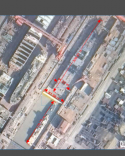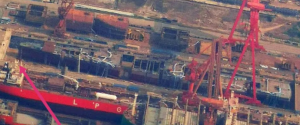Here's a list of figures I compiled, to try to get an estimate on the displacement.
I took the length and beam at waterline for various known carriers, plus whatever there's on the internet for their draft and displacement.
I am full aware of the fact some of those figures are likely not directly comparable, but there's really no way to tell which are which.
I am hoping the sheer number of various ships and the fact I am looking only for a rough estimate will overcome possible errors.
From those figures I got a coefficient value for each of the carriers. While surely not the hull shape coefficient, those values should still serve as a rough guideline. And then I applied those coefficients to the, again estimated, set of values of beam, length and draft for 003, to get a range of displacement figures.
11 m draft is really the biggest guess - for that i just copied the alleged kuznetsov draft. Most other, even bigger carriers, have very similar draft so why the heck not.
39.5 m waterline beam is my best guess judging by a range of photos back when the hull did not even reach the hangar level deck.
288 m waterline length is my best guess made based on that one photo where the shadow of the ship allowed us to observe where exactly the bow transitions into the bulbous bow which goes below water.
Anyway. I got the following set of figures:
75 000 tons if coefficient modeled after Charles de Gaulle
71 000 tons using Queen Elizabeth
64 000 tons using Kuznetsov
79 000 tons using Forrestal
72 000 tons using Kitty Hawk
77 000 tons using Enterprise
86 000 tons using Nimitz
Now, Nimitz seems an outlier, as its power train is so powerful it doesn't need to use a very efficient hull shape.
Enterprise is more interesting as it was the first nuclear fueled carrier and her whole powertrain was not really that powerful. Because of that she is at times described as using a more efficient cruiser like hull. The same could be said about CdG, which too, despite being nuclear fueled, has issues with power generation and may need a more efficient hull.
Kitty Hawk and Forrestal seem like good comparisons though, as both were powered by steam turbines powered by oil boilers. That's the expected power train the 003 will use, as far as most are expecting.
Kuznetsov too seems to be an outlier, yielding very low tonnage, but perhaps that too can be explained with a need for a VERY efficient, slender hull, as Soviets may've not had experience powering such huge ships before, so the whole powertrain would have been lacking for a heavier ship. 003 should fare better with its power train, given the Chinese experience.
That leaves us the QE carrier. I can't really explain why using its coefficient yields fairly low tonnage. If anything, I would have expected higher tonnage, due to the fact that QE doesn't need to go as fast, as it was designed to use STOVL planes. Maybe some of the public figures for QE are simply not really apples to apples kind of comparison to the rest of the carriers.
Anyway, to sum it up. Given all the above, and IF the estimated length/beam/draft figures are more or less correct - i would expect 003 to displace anywhere from low 70 thousand tons to high 70 thousand tons, at its max displacement value. Let's simplify that to around 75 thousand tons, give or take.
For USN ships, the published draft numbers are typically the limit draft or the max navigational draft. The latter includes all hull protrusions, like the bulbous bow. The former does not necessarily correspond to draft at full displacement. Judging by my measurements of DDG-51 class ships, where I compared the draft marks to the draft limit, the draft at full displacement (6.2m) can be almost 8% less than the draft limit (6.7m).
For example, the 106,000 metric ton CVN-73 has a draft limit of 12.5m. Assuming a 8% extra overloading capacity, the estimated draft at full displacement would be about 11.5m.
Can you share the table you made to compute the block coefficients so that we can compare notes?



